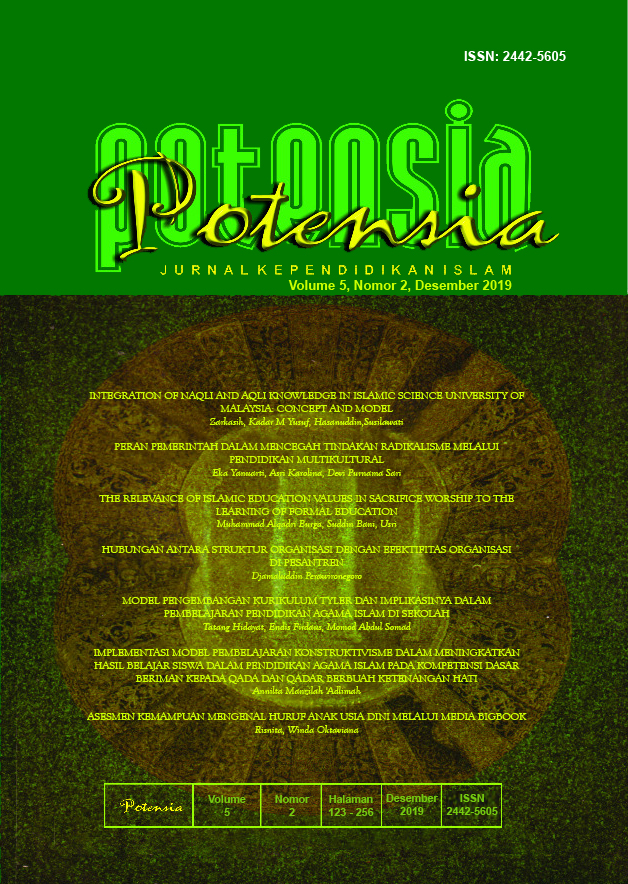ASESMEN KEMAMPUAN MENGENAL HURUF ANAK USIA DINI MELALUI MEDIA BIGBOOK
DOI:
https://doi.org/10.24014/potensia.v5i2.6575Keywords:
assesment, the ability to recognize letters, media big book, kindergartenAbstract
The ability to recognize letters is an important ability developed in children to prepare children to enter the next level of education. This study aims to develop the ability to recognize the letters in children using big book media in Mutiara Almadani Kindergarden. This research uses classroom action research approach (collaborative classroom action research). The study population is children of Mutiara Almadani Kindergarten Sungai Penuh City which amounts to 200 people which is divided into 10 study groups and sampling technique is cluster sampling, that is B3 group which is 20 children. Data collection techniques are observation, interview, documentation, and field notes. Data analysis technique used in this research is quantitative analysis with percentage and qualitative analysis. The results showed that there was an increase in the ability to recognize letters that is in the initial condition of 45% increase in cycle I to 60,42%, in cycle II increased by 75% and in cycle III to 88,33% with very developed criteria good. Thus it can be concluded that the media big book can develop the ability to recognize the letters of children in Mutiara Almadani Kindergarten Sungai Penuh City.References
Aisyah, Siti, et.al. Perkembangan dan Konsep Dasar Pengembangan Anak Usia Dini. Jakarta: Universitas Terbuka, 2010.
Aqib, Zainal. Penelitian Tindakan Kelas Bagi Pengembangan Profesi Guru. Bandung: Yrahma Widya, 2006.
Aulina, Choirun Nisak. “Pengaruh Permainan dan Penguasaan Kosakata terhadap Kemampuan Membaca Permulaan Anak Usia 5-6 Tahun.” Jurnal Pendidikan Anak Usia Dini, Vol. 6 No. 2 (2012).
Departemen Pendidikan Nasional. Undang-Undang Sistem Pendidikan Nasional. Jakarta: Departemen Pendidikan Nasional. 2003.
Dhieni, Nurbiana, et.al. Metode Pengembangan Bahasa. Jakarta: Universitas Terbuka, 2008.
Dyer, Laura. Meningkatkan Kemampuan Bicara Anak. Jakarta: Bhuana Ilmu Populer. 2009.
Hall, Usan Colville dan Barbara O’Connor. “Using Big books: A Standards-Based Instructional Approach For Foreign Language Teacher Candidates in a Prek-12 Program.” Foreign Language Annals, Vol. 39, No. 3 (2006).
Kementerian Pendidikan dan Kebudayaan. Peraturan Menteri Pendidikan dan Kebudayaan Republik Indonesia Nomor 137 Tahun 2014 tentang Standar Pendidikan Anak Usia Dini. Jakarta: Kementerian Pendidikan dan Kebudayaan. 2015.
Kustandi, Cecep. Media Pembelajaran Manual dan Digital. Bogor: Ghalia Indonesia. 2011.
Madyawati, Lilis. Strategi Pengembangan Bahasa pada Anak. Jakarta: Prenadamedia Group, 2016.
Mulyasa, E. Manajemen PAUD. Bandung: PT. Remaja Rosdakarya, 2012.
Musfiroh, Tadkiroatun. Bermain Sambil Belajar dan Mengasah Kecerdasan. Jakarta: Departemen Pembinaan Tenaga Kependidikan dan Ketenagaan Perguruan Tinggi, 2009.
Mutiah, Diana. Psikologi Bermain Anak Usia Dini. Jakarta: Kencana Prenada Media Group. 2012.
Ocbian, Magdalena M., et.al., “Big books’as Mother Tongue-Based Instructional Materials in Bicol for Grade One Pupils.” Asia Pasific Journal of Multidisciplinary Research, Vol. 3 No. 4 (2015).
Patmonodewo, Soemiarti. Pendidikan Anak Prasekolah. Jakarta: Rieneka Cipta, 2008.
Qadratillah, Meity Taqdir, et.al. Kamus Bahasa Indonesia untuk Pelajar. Jakarta: Badan Pengembangan dan Pembinaan Bahasa, Kementerian Pendidikan dan kebudayaan, 2011.
Santrock, Jhon W. Education Psycology. Newyork: McGraw-Hill, 2006.
Seefeldt, Carold dan Barbara A. Wasik. Pendidikan Anak Usia Dini. Terjemahan Piur Nasar. Jakarta: PT. Indeks, 2008.
Sholehuddin, M., et.al. Pembaharuan Pendidikan TK. Jakarta: Universitas Terbuka. 2010.
Suyanto, Kasihani K.E. English for Young Learners. Jakarta: Bumi Aksara, 2008.
Wiyani, Novan Ardy dan Barnawy. Format PAUD. Jakarta:Ar-Ruzz Media, 2012.
Yufiarti dan Titi Chandrawari. Profesionalitas Guru PAUD. Jakarta: Universitas Terbuka, 2010
Yulsyofriend. Permainan Membaca dan Menulis Anak Usia Dini. Padang: Sukabina, 2009.
Downloads
Published
How to Cite
Issue
Section
License
POTENSIA: Jurnal Kependidikan Islam operates an Open Access policy under a Creative Commons Attribution 4.0 International License. Authors who publish with this journal agree to the following terms:
- Authors retain copyright and grant the journal right of first publication with the work simultaneously licensed under a Creative Commons Attribution 4.0 International License that allows others to share the work with an acknowledgement of the work's authorship and initial publication in this journal.
- Authors are able to enter into separate, additional contractual arrangements for the non-exclusive distribution of the journal's published version of the work (e.g., post it to an institutional repository or publish it in a book), with an acknowledgement of its initial publication in this journal.
- Authors are permitted and encouraged to post their work online (e.g., in institutional repositories or on their website) prior to and during the submission process, as it can lead to productive exchanges, as well as earlier and greater citation of published work.

